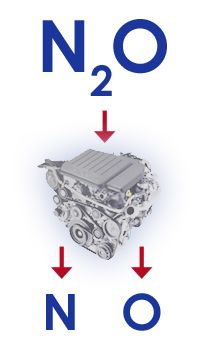
The internal combustion engine in most cars burns gasoline. To do the burning, an engine needs oxygen, and the oxygen comes from the air all around us. But what if cars carried their own and pumped pure oxygen into the engine instead?
The air around us is about 21 percent oxygen. Almost all the rest is nitrogen, which is inert when it runs through the engine. The oxygen controls how much gasoline an engine can burn. The ratio of gas to oxygen is about 1:14 -- for each gram of gasoline that burns, the engine needs about 14 grams of oxygen. The engine can burn no more gas than the amount of oxygen allows. Any extra fuel would come out of the exhaust pipe unburned.
Advertisement
So if the car used pure oxygen, it would be inhaling 100 percent oxygen instead of 21 percent oxygen, or about five times more oxygen. This would mean that it could burn about five times more fuel. And that would mean about five times more horsepower. So a 100-horsepower engine would become a 500-horsepower engine!
